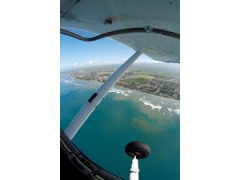Today the private pilot certificate is held by the majority of pilots. The private pilot certificate allows a pilot to act as pilot-in-command of any airplane (appropriately rated aircraft) for any non-commercial purpose. This certificate gives the pilot authority to fly under visual flight rules (VFR). A private pilot may carry passengers and fly in furtherance of a business. The private pilot certificate does not allow the pilot to be compensated in any way for services as a pilot. Passengers can pay pro rata share of the flight expenses (i.e. fuel, oil, and rental costs).
The basic requirements to obtain a private pilot certificate are:
•Be at least 17 years old
•Be able to read, speak, and write the English language
•Obtain at least a third class medical certificate from an Aviation Medical Examiner
•Pass a computerized aeronautical knowledge test
•Accumulate and log a specified amount of training and experience, including the following: ◦40 hours of piloting time including 20 hours of flight with an instructor and 10 hours of solo flight, and other requirements including "cross-country", 10 hours of solo (i.e., by yourself) flight time in an airplane, including at least ■Solo requirements: ■5 hours of solo cross-country time
■One solo cross-country flight of at least 150 NM total distance, with full-stop landings at a minimum of three points and with one segment of the flight consisting of a straight-line distance of at least 50 NM between the takeoff and landing locations
■Three solo takeoffs and landings to a full stop at an airport with an operating control tower.
■Night requirements:
■3 hours of night flight training
■One cross-country flight of over 100 nautical miles total distance
■10 takeoffs and 10 landings to a full stop (with each landing involving a flight in the traffic pattern) at an airport
■3 hours of flight training on the control and maneuvering solely by reference to instruments
•Pass an oral test and flight test administered by an FAA-designated pilot examiner.





